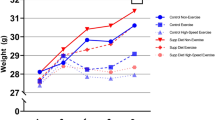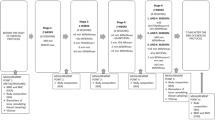Abstract
To determine whether growth hormone administration would potentiate bone response to the stimulation of exercise, 80 female rats aged 14 months were divided into control (CON), ovine growth hormone administration (0.5 mg/kg daily) (GH), treadmill exercise (17 m/minute, 60 minutes daily) (EX), and GH+EX groups for 9 and 16 weeks. Static and dynamic histomorphometry were measured on the tibial shaft and (L-5) vertebral cortical bone. The periosteal and endocortical bone formation rate of the tibial shaft were higher in both EX and GH+EX than in the CON group in the 9-week study. There is a synergistic interaction between the two interventions in both cortical surfaces. After 16 weeks of study, the cortical bone area and periosteal bone formation rate were higher only in the EX than in the CON group. In the L-5 vertebra, the labeled surface on the periosteum was higher in the EX and the bone formation rate on the endocortical surface was higher in the GH than in the CON group. However, there was a negative interaction when the two interventions were combined. We conclude that a low-dose of growth hormone administration could initially potentiate long bone response to exercise. However, from the present study, long-term treatment with low-dose growth hormone administration does not enhance the increase in bone mass from exercise.
Similar content being viewed by others
References
Colletti LA, Edward J, Gordon L, Shary J, Bell NH (1989) The effects of muscle-building exercise on bone mineral density of the radius, spine, and hip in young men. Calcif Tissue Int 45: 12–14
Bauer KD, Griminger P (1983) Long-term effects of activity and of calcium and phosphorus intake on bones and kidneys of female rats. J Nutr 113:2111–2121
Newhall KM, Rodnick KJ, van der Meulen MC, Carter DR, Marcus R (1991) Effects of voluntary exercise on bone mineral content in rats. J Bone Miner Res 6:289–296
Yeh JK, Liu CC, Aloia JF (1993) Effects of exercise and immobilization on bone formation and resorption in young rats. Am J Physiol 264:E182-E189
Canalis E, McCarthy T, Centrella M (1988) Growth factors and the regulation of bone remodeling. J Clin Invest 81:277–281
Schlechter NL, Russell SM, Spencer EM, Nicoll CS (1986) Evidence suggesting that the direct growth-promoting effect of growth hormone on cartilage in vivo is medicated by local production of somatomedin. Proc Natl Acad Sci USA 83:7932–7934
Hauschka PV, Mavrakos AE, Iafrati MD, Doleman SE, Klagsbrun M (1986) Growth factors in bone matrix: isolation of multiple types of affinity chromatography on heparin-sepharose. J Biol Chem 261:12665–12674
Harris WH, Heaney RP, Jowsey J, Cockin J, Akins C, Graham J, Weinberg EH (1972) Growth hormone: the effect on skeletal renewal in the adult dog. I. Morphometric studies. Calcif Tissue Res 10:1–13
Jorgensen PH, Bak B, Andreassen TT (1991) Mechanical properties and biochemical composition of rat cortical femur and tibia after long-term treatment with biosynthetic human growth hormone. Bone 12:353–359
Bang P, Brandt J, Degerblad M, Enberg G, Kaijser L, Thoren M, Hall K (1990) Exercise-induced changes in insulin-like growth factors and their low molecular weight-binding protein in healthy subjects and patients with growth hormone deficiency. Eur J Clin Invest 20:285–292
Yeh JK, Aloia JF, Tierney JM, Chen MM, Ling N, Koo HC, Millard WJ (in press) Effect of growth hormone administration and treadmill exercise on serum and skeletal IGF-1 in rats. Am J Physiol
Spanos EO, Barrett D, MacIntyre I, Pike JW, Safilian EF, Haussler MR (1978) Effect of growth hormone on vitamin D metabolism. Nature 273:246–247
Yeh JK, Aloia JF (1990) Effect of physical activity on calcitrophic hormone and calcium balance in rats. Am J Physiol 258:E263-E268
Rudman D, Kutner MH, Rogers CM (1981) Impaired growth hormone secretion in the adult population. Relation to age and adiposity. J Clin Invest 67:1361–1369
Takahashi S, Gottschall PE, Quigley KL, Goya RG, Meites J (1987) Growth hormone secretory patterns in young, middle-aged and old female rats. Neuroendocrinology 46:137–142
Sontag WE, Hylka VW, Meites J (1983) Impaired ability of old male rats to secrete growth hormone in vivo but not in vitro in response to hpGRF (1–44). Endocrinologsy 113:2305–2307
Rubin CT, Bain SD, McLeod KJ (1992) Suppression of the osteogenic response in the aging skeleton. Calcif Tissue Int 50: 306–313
Reddi AH (1985) Age-dependent decline in extracellular matrix-induced local bone differentiation. Isr J Med Sci 21:312–313
Liang CT, Barnes J, Seedor JG, Quartuccio HA, Bolander M, Jeffrey JJ, Rodan GA (1992) Impaired bone activity in aged rats: alterations at the cellular and molecular levels. Bone 13:435–441
Syftestad GT, Urist MR (1980) Growth hormone-dependent matrix-induced heterotropic bone formation. Proc Exptl Biol Med 163:411–415
Kimmel DB (1991) Quantitative histological changes in the proximal tibial growth cartilage of aged female rats. Cells Mater (suppl) 1:11–18
Parffit AM, Drezner MK, Glorieux FH, Kanis JA, Malluche H, Meunier PJ, Ott SM, Recker RR (1987) Bone histomorphometry: standardization of nomenclature, symbols and units. J Bone Miner Res 2:595–610
Catty D, Raykundalia C (1988) Gel immunodiffusion, immunoelectrophoresis and immunostaining methods. In: Catty D (ed) Antibodies, vol 1. IRL Press, Oxford, England, pp
Snedecor GW, Cochran WG (1980) Statistical methods, 7th ed. The Iowa State University Press, Ames, Iowa
Yeh JK, Aloia JF, Chen MM, Sprintz S (in press) A differential effect of growth hormone administration and treadmill exericse on the body composition of the middle-aged female rats. J Appl Physiol
Rudman D, Feller AG, Nagraj HS, Gergans GA, Lalitha PY, Goldberg FA, Schlenker RA, Cohn L, Rudman IW, Mattson DE (1990) Effects of human growth hormone in men over 60 years old. N Engl J Med 323:1–6
Burr DB, Martin RB, Martin PA (1983) Lower extremity loads stimulate bone formation in the vertebral column: implications for osteoporosis. Spine 8:681–686
Author information
Authors and Affiliations
Rights and permissions
About this article
Cite this article
Yeh, J.K., Aloia, J.F. & Chen, M. Growth hormone administration potentiates the effect of treadmill exercise on long bone formation but not on the vertebrae in middle-aged rats. Calcif Tissue Int 54, 38–43 (1994). https://doi.org/10.1007/BF00316288
Received:
Accepted:
Issue Date:
DOI: https://doi.org/10.1007/BF00316288




